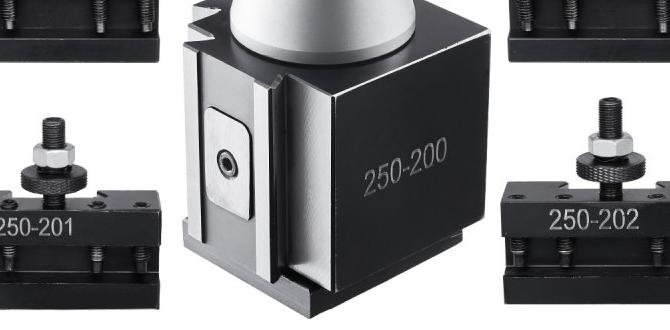A 3/16 inch carbide end mill is your go-to tool for cutting hardened steel (HRC60). Its strength and precision handle tough materials, reducing chatter and ensuring smooth, accurate results for your machining projects.
Ever tried to cut hardened steel and felt like you were fighting the machine? It’s a common challenge, especially when you’re just getting started with metalworking. Many standard end mills just can’t stand up to the toughness of hardened steel. You end up with dull tools, frustrated cuts, and maybe even a damaged workpiece. But there’s a simple solution that makes a world of difference: the 3/16 inch carbide end mill. This little powerhouse is specifically designed to tackle these tough jobs with ease. We’ll show you exactly why it’s so essential and how to use it for successful results.
Why a 3/16 Inch Carbide End Mill is Your Secret Weapon for Hardened Steel
When you’re working with materials like hardened steel, you need tools that are just as tough, if not tougher. Ordinary end mills, often made of High-Speed Steel (HSS), simply aren’t up to the task. Hardened steel has a high Rockwell hardness rating, meaning it’s exceptionally resistant to wear and deformation. Trying to machine it with an HSS end mill is like trying to cut a brick with a butter knife – it’s inefficient and ineffective.
This is where carbide shines. Carbide, or tungsten carbide to be precise, is an incredibly hard and dense material. It can withstand higher temperatures and greater cutting forces than HSS. For beginners, this translates to tools that stay sharp longer, cut cleaner, and perform more predictably, even in demanding materials. The 3/16 inch size is particularly versatile; it’s small enough for intricate details and larger features on smaller parts, yet robust enough for significant material removal when used correctly.
Understanding Hardened Steel and Its Machining Challenges
Hardened steel is steel that has undergone a heat treatment process called quenching and tempering. This process makes it significantly harder and stronger. Think of tool steels, bearing steels, or even many common components after they’ve been heat-treated for durability. The typical hardness range for what machinists call “hardened steel” often falls between HRC 50 and HRC 65. For this article, we’re focusing on materials up to HRC 60, a common target for many workshop projects.
Machining hardened steel presents several challenges:
- Tool Wear: Standard tools dull quickly, leading to poor surface finish and potential workpiece damage.
- Heat Generation: The friction of cutting creates intense heat, which can further harden the steel or damage the tool.
- Chatter: Vibrations (chatter) are common, especially with less rigid setups or inappropriate tooling. This results in rough surfaces and inaccurate dimensions.
- Cutting Forces: Hardened steel requires higher cutting forces, which can flex the tool or workpiece, leading to errors.
A 3/16 inch carbide end mill, especially one designed for hardened steel (often with specialized coatings and geometries), is engineered to overcome these obstacles.
The Power of Carbide: Why It’s Superior for Hardened Steel
Carbide’s superior hardness comes from its composition: tungsten carbide particles bonded together with a metal binder, usually cobalt. This composite material offers a unique blend of hardness, strength, and wear resistance that HSS simply cannot match. Here’s why it’s so critical for hardened steel:
- Extreme Hardness: Carbide can maintain its cutting edge at much higher temperatures than HSS. This is crucial because cutting hardened steel generates significant heat.
- Rigidity: Carbide is inherently more rigid, meaning it deflects less under cutting forces. This leads to more accurate cuts and less chatter.
- Wear Resistance: Carbide end mills resist abrasion and chipping far better than HSS, allowing them to cut through hardened materials without rapidly losing their sharpness.
- Higher Cutting Speeds: Due to its heat resistance and hardness, you can often use carbide end mills at higher speeds and feeds than HSS, leading to faster machining times.
While carbide is more brittle than HSS, meaning it can chip or fracture if used improperly (like with heavy impacts or interrupted cuts on very hard materials), for general machining of hardened steel, its benefits far outweigh this risk when used with care.
Key Features of a 3/16 Inch Carbide End Mill for Hardened Steel
Not all carbide end mills are created equal. When you’re specifically targeting hardened steel (HRC 60), look for these features:
1. Material (Carbide Grade)
Different grades of carbide exist, offering varying balances of hardness and toughness. For hardened steel, you’ll want a fine-grain carbide, which provides excellent hardness and edge strength. These are often designated with specific carbide grades (e.g., C2, C3, C4), where lower numbers indicate higher hardness but can be more brittle. For general hardened steel applications up to HRC 60, a good quality fine-grain carbide is ideal.
2. Geometry and Flute Design
- Number of Flutes: End mills for harder materials typically have more flutes (e.g., 4 or 6 flutes). More flutes allow for finer chip loads, which means shallower cuts and less stress on the tool and workpiece. They also provide better surface finish. For hardened steel, a 4-flute end mill is a good starting point and very common. Some specialized end mills for very hard materials use 5 or 6 flutes to further reduce chip load and improve surface finish.
- Helix Angle: A steeper helix angle (e.g., 30-45 degrees) can help evacuate chips more effectively and reduce cutting forces. However, for very hard and brittle materials, a lower helix angle (e.g., 20-30 degrees) might offer more rigidity and a stronger cutting edge, though it can increase cutting forces and heat. Many end mills designed for hardened steel use a standard 30-degree helix.
- Corner Radius/Chamfer: Some end mills have a small radius or a chamfer on the cutting edges. A small corner radius (e.g., 0.010″ to 0.030″ for a 3/16″ end mill) adds strength to the cutting edge, making it less prone to chipping. A slight chamfer can also improve edge strength.
3. Coatings
Coatings are thin layers applied to the surface of the carbide tool that significantly enhance performance. For machining hardened steel, look for:
- TiN (Titanium Nitride): A common, general-purpose coating that adds some hardness and lubricity, reducing friction and heat.
- TiAlN (Titanium Aluminum Nitride): Excellent for high-temperature applications and machining hard materials. It forms a protective aluminum oxide layer at high temperatures, further reducing friction and wear. This is often the preferred choice for hardened steels up to HRC 60 and beyond.
- AlCrN (Aluminum Chromium Nitride): Similar to TiAlN but can offer even better performance at very high temperatures and in abrasive conditions.
4. Shank Features
A crucial feature for preventing slipping in the collet or tool holder is a:
- Reduced Neck (or Neck Relief): This is a feature where the shank diameter is reduced behind the cutting edges. For a 3/16″ end mill with a 1/4″ or 6mm shank, a reduced neck allows the tool to cut deeper pockets or slots without the shank interfering with the workpiece. It also helps reduce vibration.
- Weldon Flat: Many end mills, especially those with larger shanks, have a flat machined onto the side of the shank. This provides a positive grip for set screws in tool holders and prevents the end mill from spinning out under heavy load. For a 3/16″ end mill, especially if it has a 1/4″ or 6mm shank, a Weldon flat is highly recommended for secure holding.
5. Size (3/16 Inch)
The 3/16 inch (approximately 4.76mm) diameter is versatile. It’s excellent for:
- Creating small features and details.
- Machining slots and pockets with precise dimensions.
- Performing light milling operations on smaller parts.
- Finishing passes to achieve tight tolerances.
When paired with features for hardened steel, this size becomes incredibly effective.
Essential Tools and Setup for Using Your 3/16 Inch Carbide End Mill
To get the most out of your carbide end mill, the right setup is key. Don’t just chuck it into any old drill chuck and start hogging away!
1. Milling Machine
A dedicated milling machine is ideal. Whether it’s a small benchtop mill (like a Sherline, Taig, or Grizzly G0704) or a larger industrial machine, rigidity is paramount. For working with hardened steel, you want a machine that is:
- Rigid: Minimizes vibration and flex.
- Accurate: Allows for precise control of movement.
- Sufficient Power: Can handle the resistance of hard materials.
Even with a smaller mill, a properly set up carbide end mill can achieve good results. For hobbyist mills, look for upgrades like ball screws or stiffer ways if possible.
2. Collet Chuck or Precision Tool Holder
This is critical for holding your end mill securely and accurately. Avoid using a standard drill chuck for end milling, especially with carbide and hard materials.
- Collet System: The best option. A collet chuck (e.g., R8, Morse taper, or ISO/SK spindle with matching collets) provides the most concentric and rigid grip on the end mill shank. Ensure you have a 3/16 inch collet or a set that includes it.
- End Mill Holder with Set Screw: If a collet system isn’t available, use a rigid end mill holder that clamps the shank tightly, preferably with a Weldon flat.
A tool holder with less than 0.001″ runout is crucial for preventing chatter and premature tool wear. You can check runout with a dial indicator.
3. Workholding
How you secure your workpiece is just as important as holding the tool.
- Vise: A sturdy, precision milling vise is common. Ensure it’s securely bolted to the machine table.
- Clamps: For larger or irregularly shaped parts, use milling clamps to firmly hold the workpiece without distorting it.
- Fixtures: Custom fixtures can provide the most secure and repeatable holding for specific parts.
The workpiece must be absolutely stationary. Any movement will lead to tool breakage or poor results.
4. Lubrication/Coolant
Machining hardened steel generates heat. Proper lubrication and cooling are essential for:
- Cooling the Tool and Workpiece: Prevents overheating, which can cause thermal shock to the carbide or re-temper the steel.
- Lubricating the Cut: Reduces friction, improving tool life and surface finish.
- Chip Evacuation: Helps wash chips away from the cutting zone.
For carbide machining of hardened steel, a dedicated cutting fluid or a mist coolant system is recommended. Some machinists use a light synthetic oil or even a water-soluble oil mixture.
5. Safety Gear
Never compromise on safety!
- Safety Glasses: Always wear ANSI-approved safety glasses or a full face shield.
- Hearing Protection: Milling can be noisy.
- Gloves: Wear appropriate gloves when handling sharp tooling and workpieces.
- Cleanliness: Keep your workspace clean to prevent tripping or accidents.
Step-by-Step Guide: Machining Hardened Steel with a 3/16 Inch Carbide End Mill
Here’s how to approach a typical milling operation. This assumes you’re doing some basic slotting or pocketing.
Step 1: Measure and Prepare Your Workpiece
Ensure your workpiece material is indeed hardened steel within the tool’s capability (e.g., HRC 55-60). Measure its dimensions accurately. If you’re starting with a raw block, ensure it’s squared up as best as possible.
Step 2: Secure the Workpiece
Mount your workpiece firmly in the vise or with clamps. Indicate the part to ensure it’s square with the machine table if necessary. Make sure it’s held absolutely solid – no movement!
Step 3: Install the End Mill
Insert your 3/16 inch carbide end mill into the appropriate collet or tool holder. Ensure the shank is seated properly. If using a Weldon flat, make sure it aligns with any set screw in the holder.
Step 4: Set Your Zero and Depth
Use your machine’s DRO (Digital Readout) or a height gauge to find the top surface of your workpiece. Set your Z-axis zero there. Then, carefully lower the tool to the desired cutting depth. Be precise!
Step 5: Program or Set Your Cutting Path
For CNC machines, this involves programming your G-code. For manual milling, you’ll use the machine’s handwheels to move the table and quill. Always plan your cuts to minimize stress and maximize chip evacuation.
Step 6: Apply Coolant/Lubricant
Turn on your coolant system or apply cutting fluid to the cutting area before you start cutting.
Step 7: Begin Milling – Setting Speeds and Feeds
This is where experience and good starting points are crucial. For a 3/16 inch carbide end mill in hardened steel (HRC 55-60), you’ll typically use:
- Spindle Speed (RPM): Lower speeds are generally used for harder materials to manage heat and vibration. A good starting range is 300-800 RPM. Always consult the end mill manufacturer’s recommendations.
- Feed Rate (IPM or mm/min): This depends heavily on the depth of cut, machine rigidity, and coolant. A conservative starting point might be 5-15 IPM (inches per minute) or 125-380 mm/min. The goal is to achieve a small, consistent chip.
- Depth of Cut (DOC): For hardened steel, shallower cuts are essential. Start with a radial depth of cut (stepover) of around 10-20% of the end mill diameter (0.018″ – 0.035″ for 3/16″). For axial depth of cut (how deep you plunge or cut down), start very conservatively, perhaps 0.050″ to 0.100″ (1.27mm to 2.54mm).
Important Tip: Listen to your machine! A smooth, consistent cutting sound is good. A high-pitched squeal or a rough, grinding noise indicates chatter or that your feed/speed is off.
Step 8: Make Shallow Passes
It’s better to take multiple shallow passes than one deep, aggressive cut. This reduces stress on the tool, workpiece, and machine. Gradually increase the depth of cut on subsequent passes if the finish and sound are good.
Step 9: Chip Evacuation
Ensure chips are being cleared effectively. If chips are packing in the flutes, you may need to increase coolant flow, slow down your feed rate, or use an air blast. For slots, pecking (plunging slightly, retracting to clear chips, then continuing) can be beneficial.
Step 10: Finishing Pass
Once you’ve reached your target depth, a final finishing pass at a slightly higher feed rate and a very shallow depth of cut (e.g., 0.002″ – 0.005″) can significantly improve the surface finish and accuracy.
Step 11: Clean Up and Inspection
After the cut, turn off the machine and clear away chips. Inspect your workpiece for dimensional accuracy and surface finish. Check your end mill for any signs of excessive wear or damage.
When to Consider Specialized Features (Like 10mm Shank Reduced Neck)
You might see carbide end mills advertised with specific features like a “10mm shank reduced neck for hardened steel HRC60 reduce chatter.” Let’s break that down:
- Reduced Neck: As mentioned, this allows for deeper reach without the shank interfering. For instance, if you need to mill a pocket deeper than the tool’s flute length, a reduced neck is essential. It also helps dampen vibrations by adding flexibility behind the cutting edge in certain load conditions.
- 10mm Shank: This is a common metric shank size. A 3/16″ (approx. 4.76mm) end mill would typically have a shank that is larger than the cutting diameter, often 4mm, 6mm, or 10





